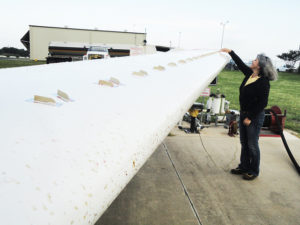Cornucopia’s Take: Certified organic farmers cannot use the synthetic pesticides commonly sprayed by conventional farmers, and all too often experience pesticide drift, or off-target spraying, by neighboring conventional and GMO farmers. The drift can result in the organic farmers’ inability to sell their contaminated produce as organic – a huge cost to organic farmers seeking premium prices for their products. This article describes one simple mechanical way for conventional farmers to cut down on drift that harms their neighbors.
The Perils of Pesticide Drift
Modern Farmer
by Sara Novak
 |
Source: USDA |
Chemical spraying misses its mark with alarming frequency, and neighboring farms—especially organic ones—often pay the price. Luckily, hope is in the air.
Andrew and Melissa Dunham spent years transforming their farm, which has been in his family for five generations, from a conventional producer of corn, soy, and alfalfa into a diversified operation with 40 different kinds of fruits and vegetables, a herd of 20 grass-fed cattle, even a few beehives. Finally, in May 2009, the couple’s 80 acres in Grinnell, Iowa—now named Grinnell Heritage Farm—became certified organic.
Just two months later, the Dunhams’ pickers spotted a crop duster flying low over nearby seed-corn fields, then noticed a cloud creeping toward them. The crew got out of the way as a fog of fungicide descended on two acres of hay, effectively revoking the acreage’s organic certification for three years, the chemical-free transition period required by the USDA.
The Dunhams’ farm regained full certification in 2012, and the following year, trouble was in the air again. “I could smell it,” says Andrew. “A metallic smell, like a railroad tie.” On the back of a 15-mph wind, a plume of insecticide from a spraying rig began wafting onto the Dunhams’ asparagus. Andrew jumped in his car and rushed to the neighbors’ farm. “To their credit, they stopped spraying,” he says. But the damage had been done: The tainted acre cost the Dunhams tens of thousands of dollars during the three years the produce couldn’t be sold at premium organic prices.
Grinnell Heritage Farm is an island of sustainable agriculture in a sea of commodity crops. Iowa leads the nation in corn and soy production, with 13.8 million acres of corn and 9.5 million acres of soybeans that together generated $14.6 billion in revenue last year. The state is also a hotbed of chemical application. Most of its farm acreage is sprayed with herbicide twice a season. Roundup Ready seed remains the norm, but many producers don’t stop at glyphosate; they also apply other powerful weed killers, such as atrazine, and insecticides, including neonicotinoids.
The Dunhams attempted to mitigate their risk by posting “No Spraying” signs and installing a 30-foot-deep perimeter of buffer shrubs; both methods obviously proved inadequate. “Applications usually result in some deposition away from the targeted site,” according to an Environmental Protection Agency spokesperson.
Though neither the EPA nor various state agencies could provide reliable statistics on the total number of drift incidents, experts agree that reported cases represent the mere tip of the iceberg. “We don’t have a good count due to underreporting,” explains Linda Wells, the Midwest director of organizing for the nonprofit Pesticide Action Network. “Many people neglect to report or do not know who to report to.” In Iowa, it’s the state department of agriculture’s pesticide bureau, which offers no online information about reporting drift. Mark Hanna, an extension agricultural engineer with Iowa State University, says, “The state receives around 200 drift complaints per year, but it’s difficult to grasp the magnitude of the problem.”
Minimizing it, however, may be possible. Drones can hover close and spray with great precision, and electrostatic spraying uses an electric charge to attract pesticide droplets to target plants. Both technologies are still years away from widespread implementation, but a potential quick fix has emerged out of the USDA’s Aerial Application Technology Research Unit (AATRU) in College Station, Texas. Large-scale farms like the ones surrounding the Dunhams’ typically opt for aerial application over ground-rig spraying, because planes cover huge swaths faster, decreasing the time workers must be sidelined (per EPA regulations that prohibit them from reentering treated areas for up to 72 hours).
Starting in 2013, Daniel Martin, a research engineer at the AATRU, and his colleagues conducted a study to determine how small wing-mounted blades called vortex generators (VGs)—intended to increase pilot control of commercial and military airplanes—might affect the way agricultural aircraft spray chemicals. Martin’s team outfitted planes with VGs and used dye in place of pesticides. In one test, the VGs reduced the amount of drift by 40 to 45 percent.
Martin, 50, hypothesizes that the tiny vortexes created by VGs help pull pesticide spray down below the plane, thus preventing it from getting caught in the airflow coming off the wings, which can cause the droplets to drift off target (see “How Vortex Generators Work,” below left). He continues to test the concept, and hopes that aerial applicators will retrofit their planes with VGs (at a cost of only about $2,000 per plane).
David Eby, a veteran aerial applicator in Wakarusa, Indiana, believes that pesticide drift will persist as long as wind and human error remain factors. “It’s like riding down the highway and expecting to keep the exhaust from your car within the boundaries of the road,” he explains. Nevertheless, the 68-year-old is intrigued by the prospect of VGs. “Reducing drift is a win for everybody,” says Eby, whose firm received only one such com- plaint after spraying 375,000 acres in 2016. Already, he employs a digital service called FieldWatch, which allows farmers with vulnerable crops and livestock to register their properties online, alerting aerial applicators to sensitive zones.
Though the Dunhams listed Grinnell Heritage Farm on FieldWatch earlier this year, they’re not overly optimistic. The couple managed to recoup some of their drift-related losses after settling with the applicators’ insurance carriers—but only after producing years’ worth of records and receipts. “It was an all- consuming task,” Andrew explains. “I’d rather have been in the fields.”

